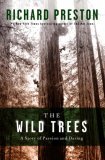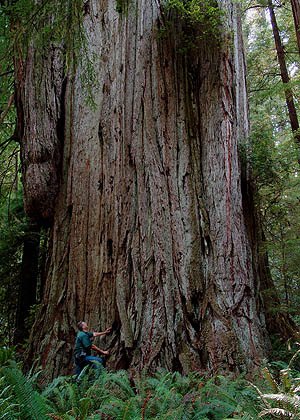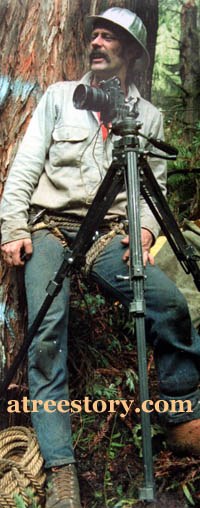
Climbing Redwoods and Potential Impact
Illegal, Recreational and Research Climbing
Continued from: Coast Redwoods Information

advertisement
by Mario D. Vaden - Copyright 2009 - 2018

Some people expressed interest about climbers in redwood canopy and the effect they may have on redwoods and upper canopy ecosystem. Especially after Preston's book was released in 2007 on the coattails of redwood canopy research. If you don't have a copy yet, click here for redwood book suggestions and ordering info.
If you have the itch to climb tall evergreens in the Pacific NW, hear ere are two places to contact for details: Pacific Climbing Institute of Eugene, Oregon, 208 miles NE of Jedediah Smith redwoods and New Tribe & Climbing Northwest of Grants Pass, OR, 72 miles NE of Jedediah Smith redwoods
Climbing the Redwoods
This essay is about climbing in protected old growth redwood forest. Not so much to provide a yes or no answer, but more to stir up thoughts. Legitimate scientific climbing should be nearly inconsequential but it's included.
This topic began with more paragraphs about recreational climbing in old growth. In time that changed. I concluded that the work and practices by researchers was a good example to help set the boundary between needful climbing and excessive climbing: between beneficial and recreational, and between consequential and inconsequential. The work and training involved with canopy research climbing can help determine the boundary between cultural neccessity and personal indulgence.
Maybe we should start with one aspect from climbing and research. I was shown a bit of data about wood growth in old redwoods, gained from measurements of trunks and leaders. It showed that ancient redwoods are putting on more growth in recent decades than in the previous few centuries. That is valuable information useful for education, forest management and even stuff like manufacturing. These kinds of results show one big difference between scientific climbing and recreational climbing when it comes to old growth protected redwoods. Research climbing is virtually essential for learning, whereas recreational climbing is optional for enjoyment.

At least 3 kinds of climbers climb tall redwoods of northern California: recreational, "sitters" and research. But redwood "sitters" won't fit the mold for this page. In various forests there may be a fourth kind for documentary photography.
Image: one guy did an illegal recreational climb of this redwood. Then put his video on Youtube where the park service saw it too. Wonder if he belongs to "Bozo Incorporated" lol
Recreational climbers are generally prohibited from climbing into canopy of national and state redwood parks. But a few people illegally sneak into redwoods without permission. Photos and videos have appeared online, proving this.
Most recreational climbers climb legally. Check TCI Climbers International. The information and forum show a glimpse of recreation climbing.
Any real concern for redwood parks would be a minority who illegally climb redwoods. One potential consequence can be damage to scientific experiment, and another consequence is disruption to rare or endangered species.
The illegal climbers are disadvantaged. They will be entering virtually blind to the knowledge of which redwoods may have scientific study equipment up in the crown, or on trunks, like sensors.
Then there are research climbers who study redwoods, birds, wildlife and epiphytes. These folks have a window of time to climb during the cool season and are granted required climbing permits. The scientists and research climbers have an advantage. Or put another way, they are prepared. They are in a position to know which redwoods have sensitive gear and have far more information than recreational people entering ignorantly.
Whether redwoods are climbed by recreational climbers or research scientists, that canopy is going to experience some degree of wear and tear. Ranging from minor and inconsequential to what I refer to as canopy trails. It's not possible to climb and have zero impact or "leave no trace behind" in the purest sense of the idea.
I've completed 1000s of pruning projects myself and one thing was essential to accomplish those: access and movement. Arborists have to move their body or tools through canopy. That requires extracting limbs and debris, inadvertent removal of moss and lichens due to standing and squeezing through gaps. Often, canopy trails were required. If none existed, some had to be made to work.
After years of hiking, I compared trails in the forests to canopy trails. In parks, frequent use of trails keeps paths clear. People stomp emerging plants, pulverize leaves and toss fallen branches. The more a trail is used the more smooth it becomes. But when trails are abandoned, plants, debris and creatures eventually recover the paths. Maintaining open trails is desireable as long as environmental problems like erosion don't become significant. But what about redwood forest canopy? Even if it's a research climber, how much of a canopy trail would you say is reasonable?
As with urban canopy, redwood crown access for scientific study requires a person to move through the canopy. Certainly caution will be employed. But however delicately a climber moves, they must grab branches, wrap ropes over limbs, stand on bark and slide clothing against buds and lichens and twigs. It's not possible to move through a redwood without changing it. Again, the forest researchers have an advantage with this. As a group they have more experience, gear and training at their disposal. And they are educated to recognize common and rare species. In a way, just as Astronauts are trained to successfully enter space, forest scientists who climb are trained to successfully enter old growth forests, the redwood universe.
Researchers may mount straps, cables, solar panels, miniature probes: you name it. For all this climbing, the person is not floating on air the whole time. For all this activity, the wear and tear from research climbing seems to be almost nil. I've had a chance to watch a few of them them climb on occassion. The result is about as close as this gets to no-trace-left-behind, with exceptions where foliage samples are gathered for research that is not possible without the samples.
I'm not supplying an answer of should or should not.
This does not boil down to just laws alone. There are people who view some old growth redwoods as gods. Others see them as mountains to be conquered. One naturalist emailed that even if they knew where the tallest redwood was they would not visit because it was holy ground to them. Some literally feel that way about these redwoods.
Now - what if climbers don't penetrate the crowns of redwoods for research, how will new information be gained? The answer is simple with 3 letters: N-O-T
But does it matter? If we choose to have trails across the ground, why not establish a few trails through ancient redwoods? And most people concede that access is neccessary to gather research data and images of species.
Pertaining to conopy ecosystem impact, wherever ropes are anchored or there is rubbing or friction, reproduction of lichens or mosses can't develop the same. Any bud broken can't become a main stem in a following century. The ancient redwoods we see are virtually the result of 100% hands-off. But does it matter when ropes contact a fraction of a fraction of surface area? For researchers that contact is a fraction of a fraction for a limited sequence of years. For recreational climbers it may be ongoing and more extensive if certain redwoods became popular climbing destinations.
It all depends on choice. If you maintain an attitude that people should keep their filthy little scummy hands off primeval redwoods, then shame on the climbers. But if you prefer to advance forest management with an alloted amount of skilled climbing, why can't that be successful? Should we be concerned over twenty pounds of branches when a single wind storm can easily remove fifty thousand pounds worth of main stems, twigs and foliage?
On the othe hand, what if recreational climbers innadvertently step on a few wandering salamanders they didn't see? Is it okay to pop a few like ketchup packets once in a while? Or bust a few rare bird eggs and nests that were unrealized?
Human curiosity feels the need to measure the tallest redwoods every year. But why not measure those redwoods every 20 years instead of every year? Realize that instruments are monitoring moisture, light and sap flow yearly; even daily. And that data should be compared to increments of growth. Researchers are gathering the data and interpretting it and should be the properly trained people to decide how frequently certain redwoods need to be climbed to gather that data.
But what about the opinion to skip the research and just not send anybody up there? Is that opinion as valid and reasonable?
And how about non-scientific measurement, like a new champion? Now that can be a hot topic. That subject is more touchy now during my 2016 edit of this page than it was in 2009 when I first posted this. Back in 2000 - 2006, researchers faced few hurdles to climb a potential champion redwood discovery for verification purposes. But Preston's book triggered a lot of attention on certain redwoods, leading to leaked locations through social media, followed by loss of vegetation. And even though most of the increased activity was on the ground, some rangers and park staff really got their panties in a wad over the extra actvity and interest. These days, we could wager that it is unlikely new champions will be climbed and measured legally under a permit, even by qualified scientists.
My thoughts about measuring new champions is that lasers are so accurate these days, it's virtually non-essential to climb to measure. A person on the ground, if they can see the top, can get the height within an inch or so. If a new tallest or largest was not going to be studied, climbing could skipped altogether.
In fact, lasers are so good now, when Michael Taylor and I found one world record pine in southern Oregon, the laser measurement was within 1mm to 2mm of the climber's tape drop. With that kind of accuracy, I question whether a climb teams tape drop is even the most accurate. If a breeze or twig put a slight bend in a long tape, that could negate a straight line measure's accuracy.
It wasn't until after several visits to groves and reviewing a bunch of documents acquired about climbing research that I began to consider frequency of climbing, whether it should occur less, the same, or more. Compared to other forests, the oldest redwood groves seem to have quite a few more epiphytes. What redwoods hold overhead for epiphytes is a drop in the bucket compared to surrounding ground vegetation. But above ground, it can be unique.
A botanical publication listed 454 kilograms of fern mat for Lost Monarch, and 677 kilograms of fern mat for Atlas redwood. Barely more weight than 5 landscape trees from a nursery in 40 gallon pots. On trees weighing 1 to 2 million pounds, proportionately it's like a few closets in the Empire State Building.
How much does it matter? If the Empire State building needed a few closets and the few were removed, then it could be very important. Water faucets and toilet paper roll dispensers account for very little space in homes or buildings but are considered very important. So for epiphytes, it boils down to how much importance or appreciation people feel for them.
Let's go another direction ...
You will agree that giant redwoods, spruce or fir are very special to some people? Is it understandable that other small or exceptionally large communities of plants or lichens are special to other people? Is there a reason that a largest single stem organism is more special than a small organism on that same large organism?

My mind-set used to be that the oldest redwoods are museum pieces, and hy not just apply a 100% hands-off approach to this limited group of groves along the west coast. That wasn't religious ... just appreciative of the nature of it. But I saw that my mind had built a boundary between limits of what is excess and what is need in regards to activity in old growth redwoods.
Note on redwood climbing history: the image shows Gerald Beranek who reached old growth redwood canopy prior to the 1980s. He is included in my Book Review Page. Beranek was "bottled and brewed" in California.
The more I think about this, and the more I learn, the more the boundary in my mind changes.
Again, researchers don't climb and throw caution to the wind. Care will be employed. I'd expect the average researcher to be impacting redwoods much less than many of the best recreational climbers. As you compare their climbing, motives and research against the innevitable minor wear and tear in the redwoods, see what conclusions you reach.
I think that the careful example and habits of scientists legitimately climbing the redwoods eliminates the need for two dozen paragraphs about illegal or ninja climbers.
By realizing how much experience and how many operations the botanists have been involved with, we can understand almost immediately how disadvantaged the illegal climbers are or potential risk they can pose, even if that risk is just accidental damage to hidden equipment.
If recreational climbers violate laws to climb redwoods, odds are they will not respect the equipment and experiments taking place either.
Focusing on the illegal climbing more ...
If recreational climbers began to climb redwoods illegally, especially a few outstanding specimens, the "canopy trails" I mentioned would eventually become well-worn. And these canopy trails would increase with size after a while. Just as more hikers stomp-down the trail, so would more climbers wear the branches and trunks smooth. The canopy soil would not just fail to accumulate, but the material that could have accumulated, would diminish intead. It would literally become a free-for-all if there were no restrictions.
Ideas about permits for recreational climbers & redwoods:
It's evident that some recreational climbers already sneak into redwood parks to climb tall redwoods. And certainly, more would like to climb the redwoods of the west coast.
Do you suppose that providing recreational climbers with permits could have it's good side? I'm not talking about unlimited seasonal permits. But a dated one-time permit for a single climb. One reason this came to mind was that ninja climbers may not know if they picked a redwood which may be a bad choice in regards to ecosystem or bird nesting. A permit system could divert impact away from redwoods with gear and areas of concern.
Personally, I don't feel opposed to trying a pilot program where climbers are allowed to climb under a recreational permit. And they could do it the same way like where photographers are required to pay for commerical photography permits.
If this were ever considered, I know the park's managment would be concerned about videos sharing the climbs. And people sharing videos and photos often do a poor job explaining requirements and the framework of things. So the sharing could trigger a surge of illegal climbers that undermines a pilot program. One option would be doing for recreational permits what's done for research climbing, that the photos do not get published on the internet. Or, posting requires showing the permit at the beginning and end, etc..
That could defeat the atmosphere of what the public redwood parks are about. But if the climbs were remote, that would handle removing the distraction. In the same way Tall Trees Grove gets less than 100 permits per day, maybe climbs could be limited to less than a hundred per week, or month. But a drawback I see, is how overly-micromanaging the parks are with other permits. Whereas Sequoia National Park doesn't require permits for cremation ashes, Redwood National and State Parks does, and even that is not very streamlined. I know for a fact, because I applied for that exact thing after my mom passed away. I applied for a permit the beginning of October. The permit wasn't sent until October 30th, the day before the single day the permit was good for, which was October 31st, the next day. And on the afternoon of the 30th when I got the file via email, it said I had to sign it and return it first for it to be valid. Between that and the two research permits I appliied for in previous years, I'm guessing there's virtually no chance for a recreational climbing permit system to work.
I will let the thoughts end there for now.
Thank you for reading,
Mario D. Vaden

advertisement

advertisement